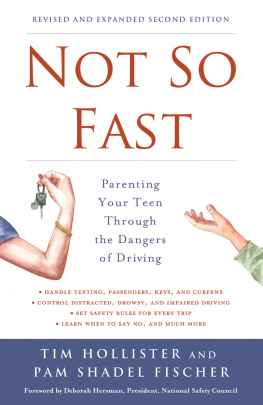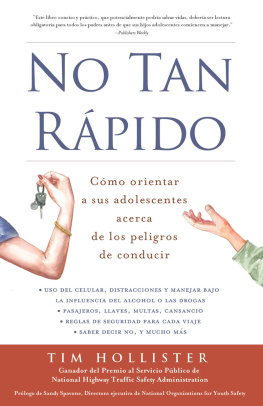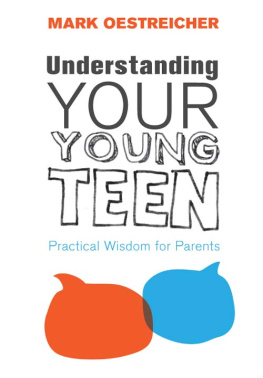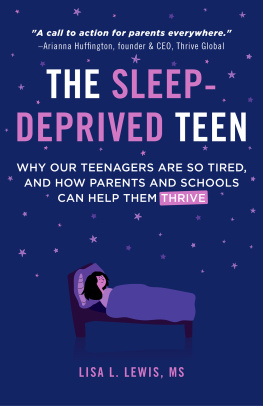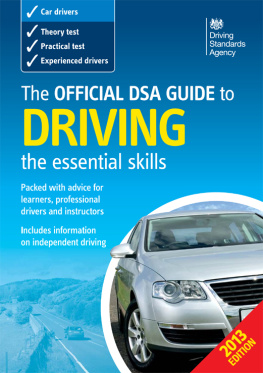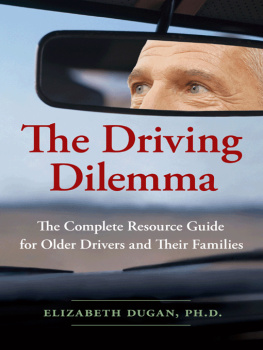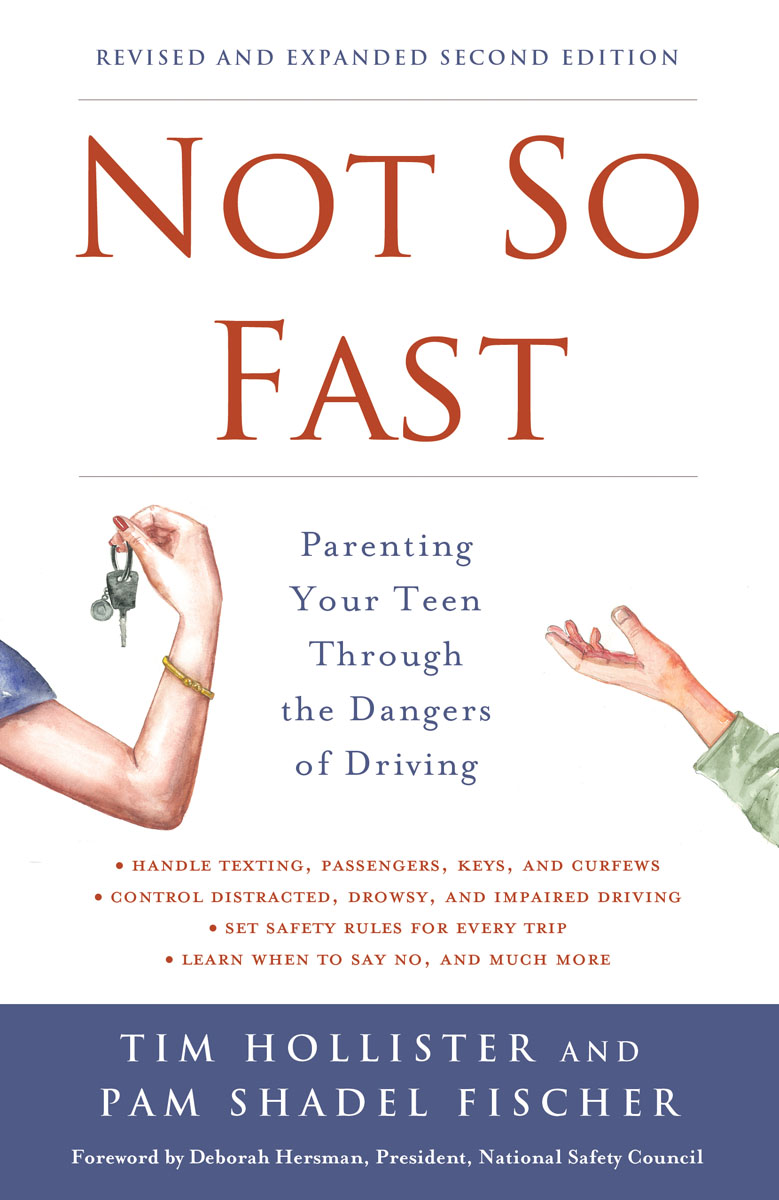

Copyright 2018 by RSH, LLC and Pam Shadel Fischer
All rights reserved
Foreword 2018 by Deborah Hersman
All rights reserved
Second edition
Published by Chicago Review Press Incorporated
814 North Franklin Street
Chicago, Illinois 60610
ISBN 978-1-61373-899-3
Library of Congress Cataloging-in-Publication Data
Names: Hollister, Tim, 1957 author. | Fischer, Pam Shadel, author.
Title: Not so fast : parenting your teen through the dangers of driving / Tim Hollister and Pam Shadel Fischer ; foreword by Deborah Hersman, President, National Safety Council.
Description: Revised and expanded second edition. | Chicago, Illinois : Chicago Review Press Incorporated, [2018] | Includes index.
Identifiers: LCCN 2017020802 (print) | LCCN 2017057120 (ebook) | ISBN 9781613739006 (adobe pdf) | ISBN 9781613739013 (epub) | ISBN 9781613739020
(kindle) | ISBN 9781613738993 (trade paper)
Subjects: LCSH: Teenage automobile drivers. | Teenage automobile driversAttitudes. | Automobile driving. | Distracted driving. | Parent and teenager. | Traffic safety.
Classification: LCC HE5620.J8 (ebook) | LCC HE5620.J8 H65 2018 (print) | DDC
629.28/30835dc23
LC record available at https://lccn.loc.gov/2017020802
Cover design: Rebecca Lown
Cover illustration: Nancy Diamond
Interior design: PerfecType, Nashville, TN
Printed in the United States of America
5 4 3 2 1
In memory of Reid Hollister, 19892006
With love for our children, Martha Hollister and Zach Fischer
D ONATION OF B OOK P ROCEEDS
Proceeds from the sale of this book benefit the Reid Hollister Memorial Fund, which is part of the endowment of the Asylum Hill Congregational Church in Hartford, Connecticut, and traffic safety programs. At the time of his death, Reid was a Sunday school teacher at Asylum Hill, beloved by kindergartners and first graders. Reids Fund benefits infant and toddler education in the City of Hartford.
N OT S O FAST IN S PANISH
Not So Fast, first edition, has been published in Spanish under the title No Tan Rpido (Chicago Review Press, 2015) and is available through bookstores and online retailers.
N OT S O FAST ON Y OU T UBE
With financial assistance from the Travelers insurance company, a six-minute video summarizing Not So Fasts key lessons for parents is available on YouTube: www.youtube.com/watch?v=QmCJKvyXhEQ.

C ONTENTS
F OREWORD
R eading this book is a down payment on your teens life. We dont talk about it enough, but the riskiest thing we let our kids do is get behind the wheel of a car. Motor vehicle crashes are the number-one killer of teens, and as parents we are the first line of defense.
Like many parents picking up this book, I am eager to keep my kids safe. As a mother of a seventeen-year-old new driver and his two younger brothers, I openly share in every parents anxiety in prepping our children for the dangers of driving. As the president of the National Safety Council, my job is to share safety trends and statisticsand when it comes to teens and driving, they arent good. When I was in high school, we were automatically enrolled in mandatory drivers education and couldnt wait to gain our independence to join friends cruising on Friday nights. Today, many schools have cut back on drivers education, and teens are waiting longer to get licensed. In some cases, these delays are counteracting graduated driver licensing laws that keep teens safer on the road during that critical first year behind the wheel. Whether your child is fifteen or eighteen, he lacks experience driving and needs you to be involved in this critical life skill development, even if he delays licensure.
The good news is that since I learned to drive, teen fatalities have been reduced by 50 percent, thanks in part to the effective advocacy and tireless dedication of grieving parents like Tim Hollister and lifelong road safety warriors like Pam Fischer, who lay out many hard-learned lessons in the pages to come. The bad news is that in recent years weve seen teen deaths rising again, and we know that almost half of all teen drivers will experience a crash before graduation. Modern-day distractions make driving even more dangerous, even while new safety features in cars abound. As Tim writes, its important to understand the changes in our social and technological environment if we are to keep our kids safe.
Parents have all heard the old adage Do as I say, not as I do, but our children have been watching us since they were babies, and they do what we do. You play a crucial role in training your teen, not just when she is preparing for her driving test but also when shes learning what not to do while behind the wheel, how to manage passengers, and how to use or misuse the technology in her hand or at her side as she drives. These are just some of the straightforward and digestible lessons imparted in Not So Fast. While our kids may not always appear to be focused on us, research shows that parents can make a significant dent in the odds of their teen being in a crash, by exhibiting the right behaviors and enforcing the simple guidelines Tim and Pam set out.
Sadly, it is parents like Tim, whove lost their son or daughter to a motor vehicle crash, who make the best teachers. Rather than taking cues from state laws that establish the minimum level of safety, and friends and neighbors who dont fully recognize the dangerous pitfalls, you have the chance to learn from Tim and Pam, experts who gracefully and knowingly outline the best way to parent a new driver in this easy-to-read book.
I am so grateful to them for providing this great roadmap for parents. There is nothing more important to teens safety and well-being than teaching them to be safe drivers. I know you are busy and have many things that demand your attention, but please spend ten minutes and read one chapter every night; it is a down payment that will pay dividends for years to come.
Deborah Hersman
President
National Safety Council
Itasca, Illinois
August 2017
A UTHORS N OTE
I n this book, teen primarily refers to those fifteen to twenty years old. Writing this book, we debated whether to refer to teens as kids or children. We recognize that every teen is different, and while some are frighteningly unready to drive at age sixteen or seventeen (or twenty-one or twenty-five), some are levelheaded and careful at fifteen. Rather than painting anyone with an unfairly broad brush, we use teen in both the gender-neutral and maturity-neutral senses.
Recognizing that many teens are supervised by someone other than a biological or adoptive parent, when we say parent we mean any adult who supervises a teens driving (and in our model teen driving agreement, we use the term supervising adult).
The National Highway Traffic Safety Administration and traffic safety advocacy organizations avoid the term accident and use crash to emphasize the fact that more than 90 percent of what happens on the road is the result of what someone did or did not do, and therefore was preventable. We agree, and use
Next page
